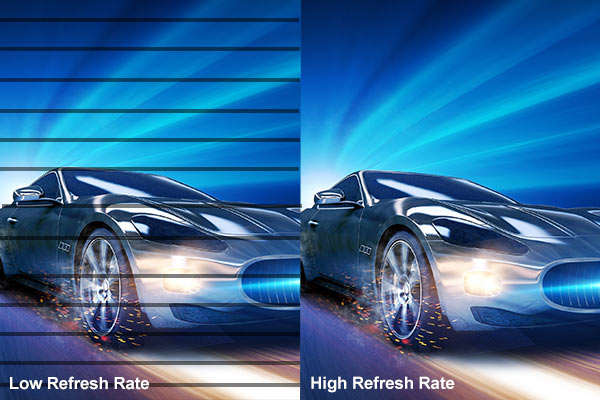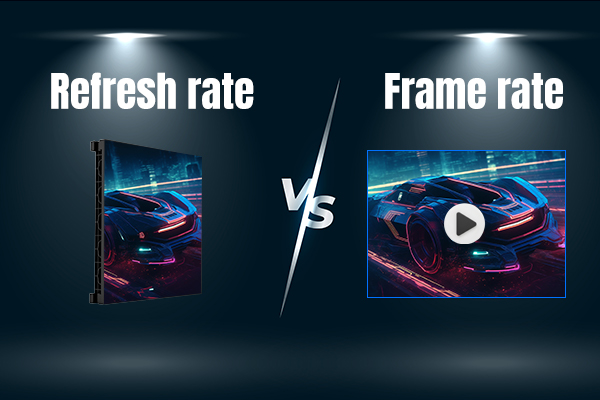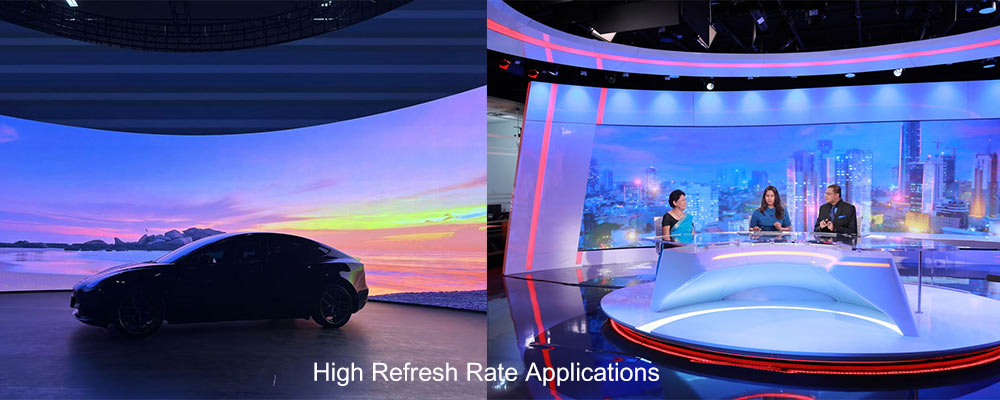Blog/2025.04.22

The refresh rate of an LED display, also termed “visual refresh frequency,” refers to the number of times the screen updates its image per second, measured in Hertz (Hz). For instance, a 60Hz refresh rate updates the display 60 times per second. A higher refresh rate ensures smoother motion, reduces flicker and enhances visual stability, which is critical for viewer comfort.

2. Refresh Rate vs. Frame Rate
Refresh rate and frame rate (FPS) are often conflated but serve distinct roles. Refresh rate is a hardware attribute dictating how often the LED display updates its content, while frame rate is an attribute of video files, representing the number of times the image information is updated per second, with the unit being Hz (Hertz). Inconsistency between refresh rate and frame rate can cause “screen tearing” and “stuttering”, which significantly affect visual performance.

3. Common Refresh Standards
3840Hz refresh rates serve well for a broad range of applications. High-end industries such as XR content creation and premium broadcast studios necessitate the superior motion handling of 7680Hz displays.

4. Technical Determinants of Refresh Rate
The refresh rate is primarily governed by LED driver chips and scanning methods:
Driver chips: The refresh rate of an LED display screen is closely related to its LED driver chip. High-end driver chips can achieve 3840Hz refresh rates or even ultra-high 7680Hz.
Scanning Methods: The scan method of an LED display refers to its row-driving method, specifically the “Time-Division Multiplexing” (TDM) scheme employed when driving the rows and columns of pixels. It is commonly expressed as “1/N scan” (where N represents the number of rows).
A. Static scan (1/1 scan): All row pixels are illuminated simultaneously, eliminating the need for row-by-row scanning.
B. 1/4 scan: The entire display is divided into groups of 4 rows, with one row in each group being illuminated simultaneously at a time.
By using a TDM-based driving scheme, the number of required driver ICs is reduced, particularly beneficial for large LED walls.
Impact of Scan Method on Refresh Rate
In scanning drive methods (non-static scanning), the overall refresh rate is constrained by the row scanning cycle. If the total refresh rate is F (Hz) and the scan rate is 1/N (with N being the number of rows), then each row refreshes every 1/(F×N) seconds. If the scanning number N increases (for example, from 1/4 to 1/16), the time available for each row refresh becomes shorter. This requires the driver chip to have a faster row switching speed, otherwise, the overall refresh rate cannot be improved.
A. Static scan (1/1): Offers no row scanning delay, making it the easiest to achieve refresh rates exceeding 3840 Hz.
B. High scan rates (e.g., 1/16): Demand higher row driving speeds. Inadequate driver IC performance may result in a reduced refresh rate ceiling.
5. Impact on Visual Comfort and Filming
Visual Comfort: During prolonged display viewing, low refresh rates may lead to eyestrain, dryness, and other discomforts. A high refresh rate eliminates flickering perceptibly to the human eye, reducing fatigue during extended viewing and ensuring sustained visual comfort for the audience.
Shooting Performance: In film and video production, a high refresh rate prevents cameras from capturing “scan lines” or “black fields” (brief intervals when LEDs are off). By significantly shortening the “black field” duration, it avoids screen flickering or dark areas in recorded footage, enhancing shot continuity and ensuring seamless transitions.

6. Industry Trends and Recommendations
Display technology is constantly evolving. 3840Hz refresh rates are becoming the preferred choice for a wide range of applications, while 7680Hz is currently being adopted for ultra-high-end uses, such as XR. When selecting a refresh rate, consider the intended application. Applications like live events and filmmaking often require high refresh rates. It’s also crucial to ensure that driver ICs, control systems, and GPUs support your target refresh rate.

Refresh rate is a key factor in LED display performance, significantly influencing viewing experience and immersive virtual filming. Understanding how refresh rate works enables informed decisions in both consumer and professional contexts.
+86-(0)731-84539619
Hunan Yestech Optoelectronic Co., Ltd. Terms of Service Privacy Policy Powered by szweb